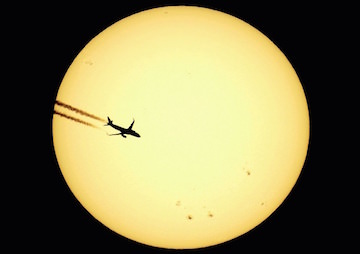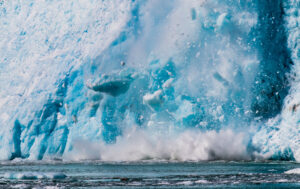Astronomers Take the Heat out of Sunspots Theory
New analysis of records stretching back 400 years to the observations of Renaissance scientist Galileo shows that global warming is not the result of solar activity. An airplane silhouetted against the sun, with sunspots clearly visible. (Sebastien Lebrigand via Wikimedia Commons)
An airplane silhouetted against the sun, with sunspots clearly visible. (Sebastien Lebrigand via Wikimedia Commons)
By Tim Radford, Climate News NetworkThis Creative Commons-licensed piece first appeared at Climate News Network.
LONDON — Forget the sunspot connection. Scientists say that rising global average temperatures cannot be attributed to them as there has been no long-term upward trend in solar activity since 1700.
An international team of astronomers looked at the historical records again, and have concluded that the collected data had been telling a confusing story. And while conclusions in science tend to be provisional, and repeatedly challenged, this latest pronouncement comes from heavyweights.
Astronomers have been counting and recording sunspots — transient dark patches on the face of the sun — since Galileo turned his homemade telescope on the heavens 400 years ago. But, historically, there have been two ways of counting and recording sunspots — and the two sets of records have differed.
Now Frédéric Clette, director of the World Data Centre of the Sunspot Index and Long-Term Solar Observations at the Royal Observatory of Belgium, Leif Svalgaard, a solar physicist at Stanford University, California, and Ed Cliver, of the US National Solar Observatory in California, have presented their findings at the 29th general assembly of the International Astronomical Union in Honolulu, Hawaii.
Data discrepancies
They recalibrated some discrepancies that existed in the two sets of historical records, and now both sets of data tell the same story: the sun hasn’t been getting busier in the last two centuries or so.
The sunspot cycle has gone on showing a pattern of change every 11 years or so, but the long-term trend is unchanged. The contribution of recent solar activity to recent global warming has remained unchanged.
That is unlikely to be the end of any argument. Only a month has passed since British and Russian physicists predicted at a meeting of British astronomers that the recent prolonged solar maximum was at an end.
The world, they said, could be experiencing a low sunspot tally by 2030, and perhaps lower temperatures of the kind historically linked to the Little Ice Age in the 17th century, characterised by frost fairs on the dense ice of the River Thames in London. That, too, coincided with a “Maunder minimum”of sunspot activity.
Statisticians do not like discrepancies in what should be two complementary ways of presenting the same evidence from one heavenly body
But the latest finding is unlikely to over-excite most climate scientists, who decided long ago that any change in the solar cycle could not be a significant factor in the long-term, upward trend in global average temperatures.
That remained predictably in step with the steady rise in carbon dioxide levels in the atmosphere, which in turn reflected the rise in fossil fuel combustion in the service of the world’s economies. But, in the way of science, they continued to check, and had already once again arrived at the same conclusion.
So the new sunspot data set remains what it has always been: humanity’s longest continuous scientific experiment, historically conducted in two ways.
The Wolf sunspot number — established in 1866 by the Swiss astronomer and mathematician, Rudolf Wolf, and still used today — is based both on the number of groups of spots, and the number of spots within each group.
First observers
The Group Sunspot Number — established as an index in 1998, but no longer maintained — was linked to methodology used by the very first sunspot observers 400 years ago, and is based solely on the numbers of groups. This was the one that showed an upward trend.
Astronomers have no stake in the climate debate. But statisticians do not like discrepancies in what should be two complementary ways of presenting the same evidence from one heavenly body.
The guardians of the data took another look at what might have gone wrong. It was this trend that has now been identified as the consequence of an error in calibrating the two sets of data.
So now climate science historians, who rely on solar data to help make sense of evidence from tree rings and ice cores, may have to think again. But the picture of global warming remains unchanged.
Your support is crucial…With an uncertain future and a new administration casting doubt on press freedoms, the danger is clear: The truth is at risk.
Now is the time to give. Your tax-deductible support allows us to dig deeper, delivering fearless investigative reporting and analysis that exposes what’s really happening — without compromise.
Stand with our courageous journalists. Donate today to protect a free press, uphold democracy and unearth untold stories.









You need to be a supporter to comment.
There are currently no responses to this article.
Be the first to respond.